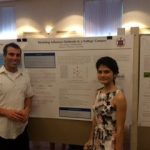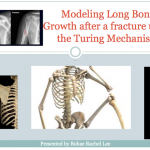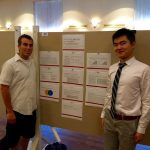The central goal of my research is to use mathematics to better understand and manage natural populations. The role of theory in this process is to help uncover the mechanisms driving these systems and therefore improve the effectiveness of various control strategies. My research combines the development of mechanistic models describing spatio-temporal systems with statistical inference based on data. Systems I have applied these techniques to include: predator-prey oscillators, the spread of infectious disease, and the opioid-epidemic.
The left figure illustrates the canonical example of spatial synchrony: the dynamics created by the predator-prey interactions of the lynx and the snowshare hare in Canada. My dissertation research uses the Theory of Weakly Coupled Oscillators to investigates the cause(s) of this interspecific spatial synchrony, where the leading explanations are migration and extrinsic climatic events.
The middle figure is a photograph on the North American gypsy moth. The gypsy moth is an invasive forest defoliator that causes widespread agriculture and forest damage. Aided by field data gathered by the Dwyer Lab, I am developing and fitting mechanistic models describing the interactions between the gyspy moth and its two primary pathogens, a density dependent NPV virus and a weather dependent fungus E. Maimaiga.
The figure on the right describes the number of reported cases of pertussis (also known as whooping cough) in the United States. While there are several leading hypothesis as to why there is this modern resurgence in incidence despite continued high vaccination rates, there is as yet no consensus. I am focused on trying to understand the role of spatial coupling in driving the interesting spatial patterns observed in the data.
Student Research:
During the academic year 2018-2019, I was awarded a mini-grant from the Center for Undergraduate Research in Mathematics (CURM), to lead a group of five undergraduates researching the Opioid Epidemic. Our group consisted of UP students: Bryce Amato, Meghan Childs, Ruth Olson, Samantha Rivas, and Alexandra Tessner. Together, this group built an SIR-type compartmental model describing the relative roles of the four most commonly prescribed opioids on the size of this epidemic. They also used performed regression to examine the relationship between prescription rates and overdose death and the counter-intuitive recent inverse relationship between those two. They presented this work with talks at Founder’s Day at UP, the Spring 2019 MAA regional meeting, and at the Regional Annual meeting of AAAS. Sam and Alex continued this research with an independent study during academic year 2019-2020, they added to the model by approximating the addiction risk and prescription rates of each of the four most commonly prescribed opioids and performing sensitivity analyses on the size of the opioid epidemic with respect to each prescription rate. They found that oxycodone and codeine prescriptions played a larger roll than hydrocodone prescriptions. A manuscript based on these results has been published in Mathematical Medicine and Biology: A Journal of the IMA (link)
Subekshya Bidari created several stochastic SIR-type models describing three separate outbreaks of influenza that occurred at Trinity College in  the spring of 2014 and 2016. Using data from the Trinity College Health Center on student influenza incidence and vaccination rates, Subekshya fit her models to this data using maximum likelihood techniques. More recent iterations of these models include different assumptions about the social networks of students and how that impacts disease transmission. Finally, we evaluated the Subekshya has presented this research with talks at MathFest (2015 and 2016) and a poster presentation at the MBI organized Undergraduate Capstone Conference. This work has been published in the journal Letters in Biomathematics (link)
the spring of 2014 and 2016. Using data from the Trinity College Health Center on student influenza incidence and vaccination rates, Subekshya fit her models to this data using maximum likelihood techniques. More recent iterations of these models include different assumptions about the social networks of students and how that impacts disease transmission. Finally, we evaluated the Subekshya has presented this research with talks at MathFest (2015 and 2016) and a poster presentation at the MBI organized Undergraduate Capstone Conference. This work has been published in the journal Letters in Biomathematics (link)
Kevin Liu and Shufan Wang completed an independent study with me on Convolutional Neural Networks for Visual Recognition. We followed an existing Stanford Class with of the same name (link). Using an existing library of photographs (CIFAR-10) as our training data, Kevin and Shufan created a convolutional neural network to identify additional (new) photographs. Network properties included a batch normalization layer, dropout, a pooling layer, and some preprocessing. As a “thank you project”, they created below images. Using neural style transfer, they passed an image of me (left) and allowed the image of me to adapt to the style of two famous paintings (Starry Night – middle, The Great Wave of Kanagawa – right)

Rachel Lee wrote her senior thesis on a reaction-diffusion PDE model d escribing the growth and repair of long bones. Rachel non-dimensionalized and simulated this model using the Crank-Nicholson numerical method. She found the parameter region that leads to the Turing Mechanism that mimics the concentration of two proteins critical in the biology of bone growth and repair.
escribing the growth and repair of long bones. Rachel non-dimensionalized and simulated this model using the Crank-Nicholson numerical method. She found the parameter region that leads to the Turing Mechanism that mimics the concentration of two proteins critical in the biology of bone growth and repair.
 Kalyan Parajuli created a novel adaptive time-step differential equation solver for a predator-prey oscillator. Kalyan calculated the phase response curve (the sensitivity of an oscillator’s phase to an external perturbation) and then built the solver to minimize the error after trying different relationships between the phase response curve and the time-step of the method. Kalyan presented his research with a poster at the Trinity College Annual Science Symposium.
Kalyan Parajuli created a novel adaptive time-step differential equation solver for a predator-prey oscillator. Kalyan calculated the phase response curve (the sensitivity of an oscillator’s phase to an external perturbation) and then built the solver to minimize the error after trying different relationships between the phase response curve and the time-step of the method. Kalyan presented his research with a poster at the Trinity College Annual Science Symposium.
Yaoqi Guo  studied the effectiveness of the Math Placement exam administered at Trinity using data from the last six years of students’ exam scores, high school GPA, SAT scores, and grade outcomes. Yaoqui looked at relationships between placement exams scores and outcome using chi-squared distribution, multiple regression analysis, student t-tests, and summary statistics. Yaoqui presented his research with a poster at the Trinity College Annual Science Symposium.
studied the effectiveness of the Math Placement exam administered at Trinity using data from the last six years of students’ exam scores, high school GPA, SAT scores, and grade outcomes. Yaoqui looked at relationships between placement exams scores and outcome using chi-squared distribution, multiple regression analysis, student t-tests, and summary statistics. Yaoqui presented his research with a poster at the Trinity College Annual Science Symposium.
Pranav Bhandari compared the numerical error between a variety of different numerical methods approximating solutions to the Lotka-Volterra predator-prey model. Pranav looked at fixed time step methods of different orders, two-step methods, implicit methods, and adaptive-time step methods and compared the error propagated in each method with the computational complexity of the method. Pranav presented his research with a poster at the Trinity College Annual Science Symposium.


